April 15, 1452 - May 2, 1519
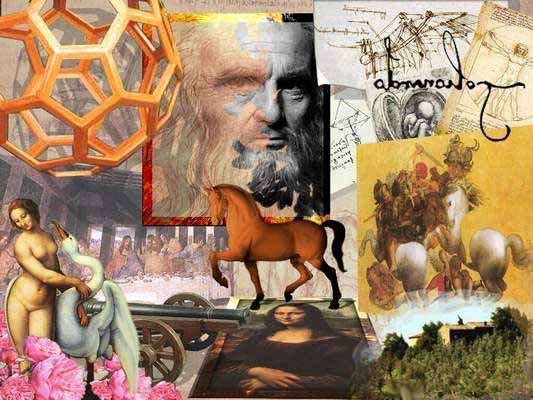
April 15, 1452 - May 2, 1519

Leonardo Da Vinci was an Italian painter, draftsman, sculptor, architect, engineer, visionary and inventor who designed buildings, bridges, canals, forts, war machines, submarines, more.
He kept huge notebooks with sketches of his ideas. Among these, he was fascinated by birds and flying and his sketches include such fantastic designs as flying machines.
These drawings demonstrate a genius for mechanical invention and insight into scientific inquiry, truly centuries ahead of their time.
His greater fame lies in being one of the greatest painters of all times, best known for such paintings as the Mona Lisa and The Last Supper (see below).
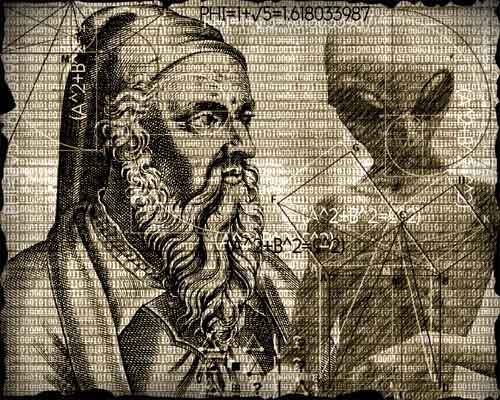
It is believed that much of Da Vinci's art, illustrations, and engineering designs are encoded with hidden messages and mysteries that foresaw future inventions and technology.
He believed that humans were to alone. If he ever had an encounter with an extraterrestrial being, it was not part of his journals and notebooks, or anything he ever shared that became public.
Having a brilliant mind and seeming to access information from 'somewhere else' - Ancient Alien theorist suggest that da Vinci had otherworldly guidance whether he understood where his information and imagery was coming from or not.

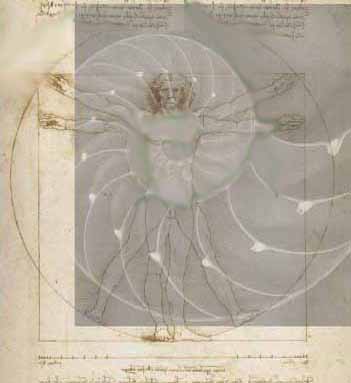
Reality is a simulation 'written' in consciousness grids to which some people are programmed to access information to help advance their society and timeline. None of this is by accident. Everything is by design.
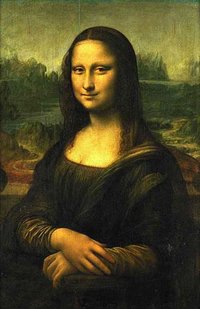
Leonardo began work on the Mona Lisa (also known as La Gioconda, now at the Louvre in Paris) in 1503, which he did not finish until 1506. He most likely kept it with him at all times, and did not travel without it.
Thousands of people see it each year in the Louvre, perhaps drawing their own interpretation on what is known as the Mona Lisa's most infamous and enigmatic feature - her smile.
It is well known that Leonardo used sacred geometry in this painting, including the so-called Golden Ratio.
The Mona Lisa was probably his favorite piece because there is so much more than meets the eye.
The name Mona Lisa is not the one given to the piece of art at the time, nor was it known by this title until much later.
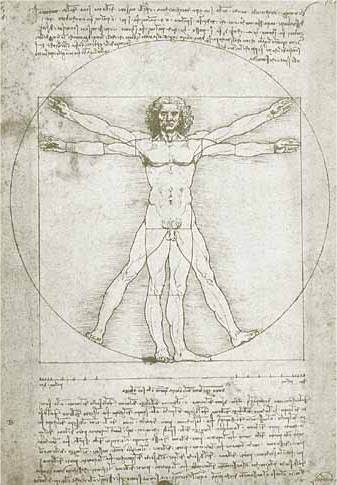
Vitruvian Man - 1498
Leonardo da Vinci draws the human body
Leonardo discovered the anatomy of the human body at the time he was apprenticed to Andrea del Verrocchio, as his teacher insisted that all his pupils learn anatomy.
DaVinci participated in autopsies and produced many extremely detailed anatomical drawings, planning a comprehensive work of human and comparative anatomy.
Around the year 1490, he produced a study in his sketchbook of the "Canon of Proportions" as described in recently rediscovered writings of the Roman architect Vitruvius.
The study, called the Vitruvian Man, is one of his most well-known works.
As he became successful as an artist, he was given permission to dissect human corpses at the hospital Santa Maria Nuova in Florence.
Later he dissected in the hospital Maggiore and in Rome in the hospital Santo Spirito (the first mainland Italian hospital).
From 1510 to 1511 he collaborated with the doctor Marcantonio della Torre (1481 to 1511).
In 30 years, Leonardo dissected 30 male and female corpses of different ages. Together with Marcantonio, he prepared to publish a theoretical work on anatomy and made more than 200 drawings.
However, his book was published only in 1580 (long after his death) under the heading "Treatise on Painting".
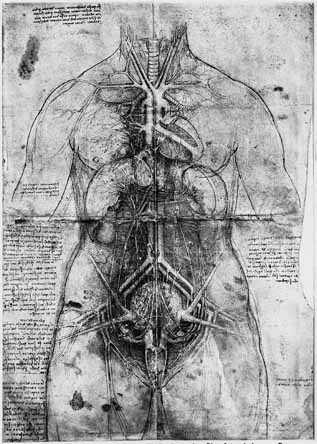
Leonardo drew many images of the human skeleton, and was the first to describe the double S form of the backbone.
He also studied the inclination of pelvis and sacrum and stressed that sacrum was not uniform, but composed of five vertebrae. He was also able to represent exceptionally well the human skull and cross-sections of the brain (transversal, sagittal, and frontal). He drew many images of the lungs, mesentery, urinary tract, sex organs, and even coitus.
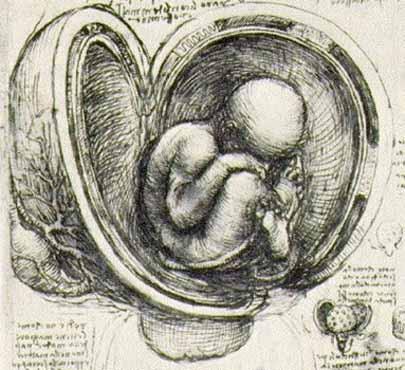
He was one of the first who drew the fetus in the intrauterine position (he wished to learn about "the miracle of pregnancy"). He often drew muscles and tendons of the cervical muscles and of the shoulder.
He was a master of topographic anatomy. He not only studied the anatomy of human, but also of other beings. It is important to note that he was not only interested in structure but also in function, so he was anatomist and physiologist at the same time.
Because he actively searched for bodily deformed people to paint them, he is also considered to be the beginner of caricature.His study of human anatomy led also to the design of the first known robot in recorded history.
The design, which has come to be called Leonardo's robot, was probably made around the year 1495 but was rediscovered only in the 1950s.
It is not known if an attempt was made to build the device.
He correctly worked out how heart valves eddy the flow of blood yet he was unaware of circulation as he believed that blood was pumped to the muscles where it was consumed.
A diagram drawing Leonardo did of a heart inspired a British heart surgeon to pioneer a new way to repair damaged hearts in 2005.
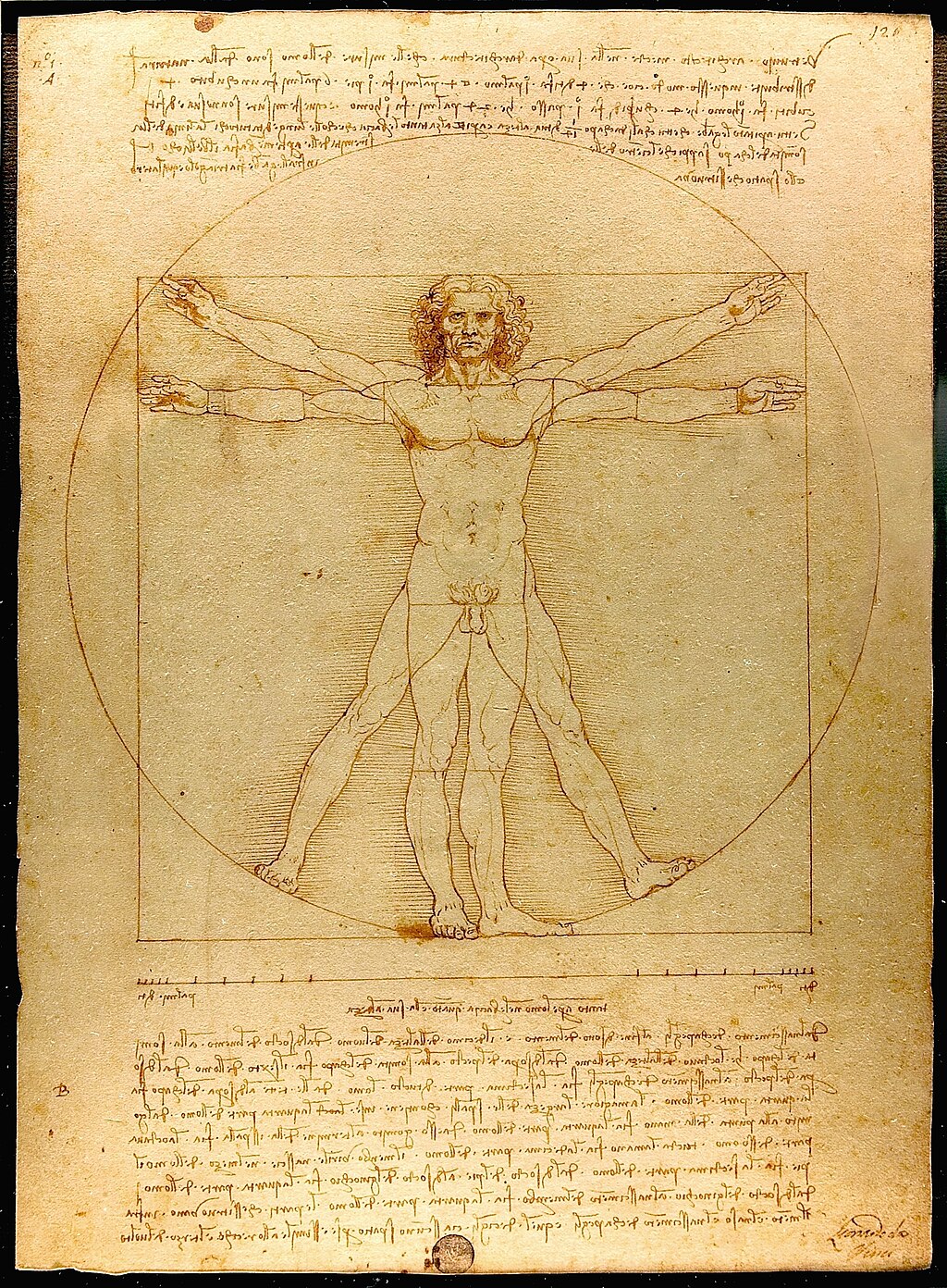
Hidden Detail in Crotch Solves 500-Year-Old Leonardo Da Vinci Mystery - It's all About Geometry Science Alert - July 18, 2025
Leonardo da Vinci, the famous Italian polymath who painted the Mona Lisa, had a sophisticated geometric understanding way ahead of his time. To draw the Vitruvian Man in 1490 - an illustration of the 'ideal' human body - the Renaissance man may have relied on a mathematical ratio not formally established until the 19th century. It's one of the most iconic images of all time, and yet for more than 500 years, no one could figure out why da Vinci chose such specific proportions for the arms and legs.
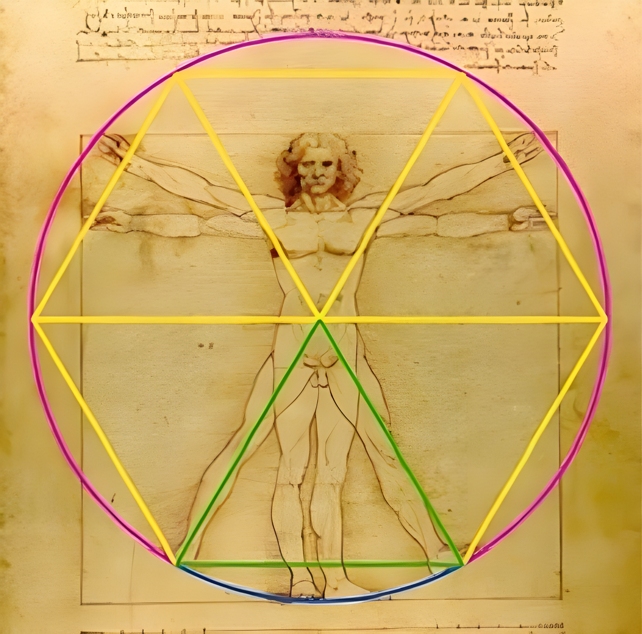
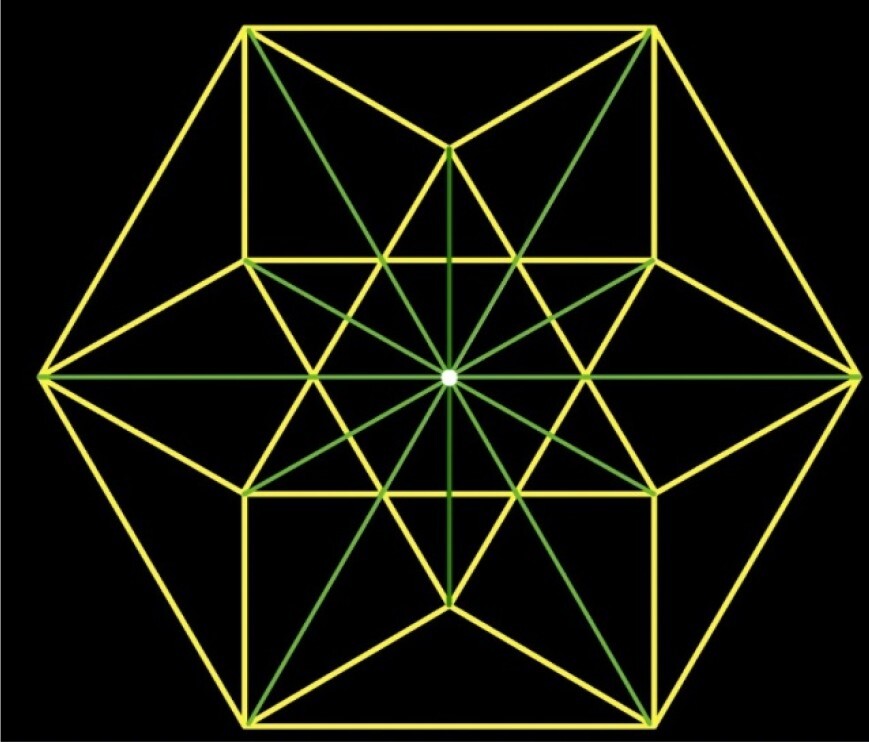
Rory Sweeney has found a crucial hidden detail, tucked in the Vitruvian Man's crotch: an equilateral triangle that he thinks may explain one of the most analyzed yet cryptic works in art history. The Vitruvian Man is partly inspired by the writings of Roman architect Vitruvius, who argued that the perfect human body should fit inside a circle and square. Da Vinci's drawing uses a square to precisely contain a 'cruciform pose', with arms outstretched and legs in. The circle, meanwhile, encompasses a posture where the arms are raised and the legs are spread.
The first known biography of Leonardo was published in 1550 by Giorgio Vasari who wrote Vite de' piu eccelenti architettori, pittori e scultori italiani ("The lives of the most excellent Italian architects, painters and sculptors"), and later became an independent painter in Florence.
Most of the information collected by Vasari was from first-hand accounts of Leonardo's contemporaries, (Vasari was only a child when Leonardo died), and it remains the first reference in studying Leonardo's life.
Leonardo was born in Anchiano, near Vinci, Italy. He was an illegitimate child. His father, Ser Piero da Vinci was a young lawyer and his mother, Caterina, was probably a peasant girl. It has also been suggested, albeit on scanty evidence, that she was a Middle Eastern slave owned by Piero. However, the latter theory is unlikely to be true.
As he was born before modern naming conventions developed in Europe, his full name was "Leonardo di ser Piero da Vinci", which means "Leonardo, son of Mister Piero, from Vinci". Leonardo himself simply signed his works "Leonardo" or "Io, Leonardo" ("I, Leonardo").
Most authorities therefore refer to his works as "Leonardos", not "da Vincis". Presumably he did not use his father's name because of his illegitimate status.
Leonardo grew up with his father in Florence. Here, he started drawing and painting. His early sketches were of such quality that his father soon showed them to the painter Andrea del Verrocchio who subsequently took the fourteen-year old Leonardo on as an apprentice. Later, he became an independent painter in Florence.
In 1476, he was accused anonymously, along with three other men, of sodomy with a 17 year-old model, Jacopo Saltarelli, who was a notorious male prostitute.
After two months in jail, he was acquitted because no witnesses stepped forward. For some time afterwards, Leonardo and the others were kept under observation by Florence's Officers of the Night - a kind of Renaissance vice squad, charged with suppressing the practice of sodomy, which a majority of male Florentines engaged in, as shown by surviving legal records of the Podesta and the Officers of the Night.
Modern critics contend that Leonardo's love of boys was well-known even in the sixteenth century. Rocke reports that in a fictional dialogue on l'amore masculino (male love) written by the contemporary art critic and theorist Gian Paolo Lomazzo, Leonardo appears as one of the protagonists and declares, "Know that male love is exclusively the product of virtue which, joining men together with the diverse affections of friendship, makes it so that from a tender age they would enter into the manly one as more stalwart friends."
In the dialogue, the interlocutor inquires of Leonardo about his relations with his assistant, Salai, "Did you play the game from behind which the Florentines love so much?"
Leonardo kept his private life particularly secret, and there is no evidence that Leonardo was ever intimately involved with any woman, nor in a close friendship with one. He also surrounded himself with handsome young men throughout his life, and his art reflects an appreciation of androgynous beauty. It has, therefore, been assumed that he was a homosexual. One of his loves may have been Gian Giacomo Caprotti da Oreno (nicknamed Salai (Little Devil)). Gian entered Leonardo's household around 1488 at the age of 10, becoming his servant and assistant.
In 1506, Leonardo met Count Francesco Melzi, the fifteen year old son of a Lombard aristocrat. Salai eventually accepted Melzi's continued presence and the three undertook various journeys throughout Italy.
Though Salai was always introduced as Leonardo's "pupil", he never produced any work of artistic merit. Melzi, however, became his pupil and life companion. Leonardo had many other friends who are now figures renowned in their fields, or for their influence on history; these included Niccol˜ Machiavelli, Cesare Borgia and Franchinus Gaffurius.
Disregarding the controversy of homosexuality, it is clear from the works of Leonardo and his early biographers, that he was a man of high integrity and very sensitive to moral issues. Hereby, it should be noted that Leonardo was a vegetarian at least a part of his life and often bought birds just to release them. He was also the respected judge on the matters of beauty and elegance, particularly in pageantry.
It was believed that Leonardo was gay - keeping his private life particularly secret, and going as far as writing his journals in code.
He also claimed to have a distaste of physical relations: The act of procreation and anything that has any relation to it is so disgusting that human beings would soon die out if there were no pretty faces and sensuous dispositions, a comment later interpreted by Freud, in an analysis of the artist, as indicative of his "frigidity" (Gesammelte Werke bd VIII, 1909-1913).
He concludes that Leonardo is driven by a homosexual libido, one that is sublimated in his scientific investigations. Indeed, Leonardo surrounded himself with handsome youths throughout his life, and allowed his art to reflect an appreciation of masculine beauty.
His lasting and loving relationship with young men and lack of close relationships with women, together with surviving legal records and contemporary writings have led many modern historians to conclude that he had a strong erotic interest, one focused exclusively on males.
The first known instance of his interest in youths occurred in 1476. While still living with Verrocchio, he was twice accused anonymously of sodomy with a 17 year-old model, Jacopo d'Andrea Saltarelli, a boy already known to the authorities for his sexual escapades with men.
After two months in jail, he was acquitted because no witnesses stepped forward. For some time afterwards, Leonardo and the others were kept under observation by Florence's Officers of the Night - a Renaissance organization charged with suppressing the practice of sodomy, as shown by surviving legal records of the Podesta and the Officers of the Night.
Leonardo's alleged love of boys was a topic of discussion even in the sixteenth century. In "Il Libro dei Sogni " (The Book of Dreams) a fictional dialogue on l'amore masculino (male love) written by the contemporary art critic and theorist Gian Paolo Lomazzo, Leonardo appears as one of the protagonists and declares, "Know that male love is exclusively the product of virtue which, joining men together with the diverse affections of friendship, makes it so that from a tender age they would enter into the manly one as more stalwart friends."
In the dialogue, the interlocutor inquires of Leonardo about his relations with his assistant, il Salaino, "Did you play the game from behind which the Florentines love so much?" Leonardo answers, "And how many times! Keep in mind that he was a beautiful young man, especially at about fifteen."
Gian Giacomo Caprotti da Oreno, nicknamed il Salaino ("The Little Unclean One" i.e., the devil), was described by Vasari as "a graceful and beautiful youth with fine curly hair, in which Leonardo greatly delighted." Il Salaino entered Leonardo's household in 1490 at the age of 10.
The relationship was not an easy one. A year later Leonardo made a list of the boy's misdemeanors, calling him "a thief, a liar, stubborn, and a glutton." The "Little Devil" had made off with money and valuables on at least five occasions, and spent a fortune on apparel, among which twenty four pairs of shoes.
Nevertheless, il Salaino remained his companion, servant and assistant for the next thirty years, and Leonardo's notebooks during their early years contain pictures of a handsome, curly-haired adolescent.
Il Salaino's name also appears (crossed out) on the back of an erotic drawing (ca. 1513) by the artist, The Incarnate Angel, at one time in the collection of Queen Victoria. It is seen as a humorous and revealing take on his major work, St. John the Baptist, also a work and a theme imbued with homoerotic overtones by a number of art critics such as Martin Kemp and James Saslow (Saslow, 1986, passim).
Another erotic work, found on the verso of a foglio in the Atlantic Codex, depicts il Salaino's behind, towards which march several penises on two legs (Augusto Marinoni, in "Io Leonardo", Mondadori, Milano 1974, pp.288, 310). Some of Leonardo's other works on erotic topics, his drawings of heterosexual human sexual intercourse, were destroyed by a priest who found them after his death.
In 1506, Leonardo met Count Francesco Melzi, the 15 year old son of a Lombard aristocrat. Melzi himself, in a letter, described Leonardo's feelings towards him as a sviscerato et ardentissimo amore ("a passionate and most fiery love").
Salai eventually accepted Melzi's continued presence and the three undertook journeys throughout Italy. Though Salai was always introduced as Leonardo's "pupil", he never produced any work of artistic merit. Melzi, however, became Leonardo's pupil and life companion, and is considered to have been his favorite student.
Both of these relationships follow the pattern of eroticized apprenticeships which were frequent in the Florence of Leonardo's day, relationships which were often loving and not infrequently sexual.
Besides them, Leonardo had many other friends who are now figures renowned in their fields, or for their influence on history. These included Cesare Borgia, in whose service he spent the years of 1502 and 1503. During that time he also met Niccolo Machiavelli, with whom later he was to develop a close friendship. Also among his friends were counted Franchinus Gaffurius and Isabella d'Este, whose portrait he drew while on a journey which took him through Mantua.
Leonardo was left-handed and used mirror writing throughout his life. This is explainable by the fact that it is easier to pull a quill pen than to push it. By using mirror-writing, the left-handed writer is able to pull the pen from right to left.
Leonardo pioneered new painting techniques in many of his pieces. One of them, a color shading technique called Chiaroscuro, used a series of glazes custom-made by Leonardo. It is characterized by subtle transitions between color areas, creating an atmospheric haze or smoky effect. Chiaroscuro is a technique of bold contrast between light and dark.
Scientists identify secret ingredient in Leonardo da Vinci paintings - egg yolks CNN - March 29, 2023
"Old Masters" such as Leonardo da Vinci, Sandro Botticelli and Rembrandt may have used proteins, especially egg yolk, in their oil paintings, according to a new study. Trace quantities of protein residue have long been detected in classic oil paintings, though they were often ascribed to contamination. A new study found the inclusion was likely intentional - and sheds light on the technical knowledge of the Old Masters, the most skilled European painters of the 16th, 17th, or early 18th century, and the way they prepared their paints.
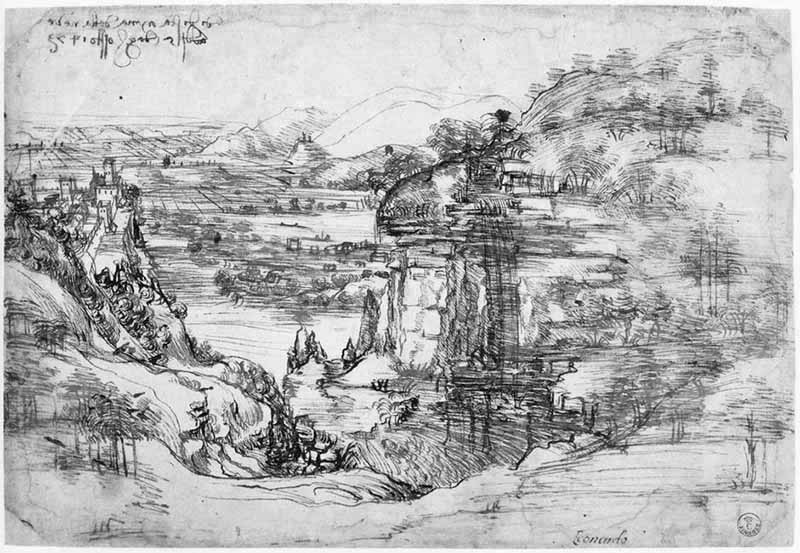
Leonardo's earliest known dated work is a drawing done in pen and ink of the Arno valley, drawn on the August 5, 1473.
It is assumed that he had his own workshop between 1476 and 1478, receiving two orders during this time.
From around 1482 to 1499, Ludovico Sforza, Duke of Milan, employed Leonardo and permitted him to operate his own workshop complete with apprentices.
It was here that seventy tons of bronze that had been set aside for Leonardo's "Gran Cavallo" horse statue were cast into weapons for the Duke in an attempt to save Milan from the French under Charles VIII in 1495.
When the French returned under Louis XII in 1498, Milan fell without a fight, overthrowing Sforza.
Leonardo stayed in Milan for a time, until one morning when he found French archers using his life-size clay model of the "Gran Cavallo" for target practice. He left with Salai and his friend Luca Pacioli (the first man to describe double-entry bookkeeping) for Mantua, moving on after 2 months to Venice (where he was hired as a military engineer), then briefly returning to Florence at the end of April 1500.
In Florence he entered the services of Cesare Borgia, the son of Pope Alexander VI, acting as a military architect and engineer; with Cesare he travelled throughout Italy. In 1506 he returned to Milan, now in the hands of Maximilian Sforza after Swiss mercenaries had driven out the French.
From 1513 to 1516, he lived in Rome, where painters like Raphael and Michelangelo were active at the time, though he did not have much contact with these artists. However, he was probably of pivotal importance in the relocation of David (in Florence), one of Michelangelo's masterpieces, against the artist's will.
In 1515 Francis I of France retook Milan, and Leonardo was commissioned to make a centrepiece (a mechanical lion) for the peace talks between the French king and Pope Leo X in Bologna, where he must have first met the King.
In 1516, he entered Francis' service, being given the use of the manor house Clos Luce (also called "Cloux") next to the king's residence at the royal Chateau Amboise.
The King granted Leonardo and his entourage generous pensions: the surviving document lists 1000 ecus for the artist, 400 for Melzi (named "apprentice") and 100 for Salai (named "servant").
In 1518 Salai left Leonardo and returned to Milan, where he eventually perished in a duel. Francis became a close friend. He died at Clos Luce, France, on 2nd May, 1519.
According to his wish, 60 beggars followed his casket. He was buried in the Chapel of Saint-Hubert in the castle of Amboise. Although Melzi was his principle heir and executor, Salai was not forgotten; he received half of Leonardo's vineyard.
The person standing to Jesus' right is thought to be Mary Magdalene
The Last Supper (1495-1498). Mural, tempera on gesso, pitch and mastic, 700 x 880 cm (22.9 x 28.8 ft).
In the Santa Maria delle Grazie Church, Milan, Italy, we find Leonardoi's dramatic interpretation of Jesus' last meal before death. Depictions of the Last Supper in Christian art have been undertaken by artistic masters for centuries, Leonardo da Vinci's late-1490s mural painting, being the best-known example.
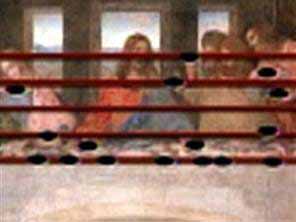
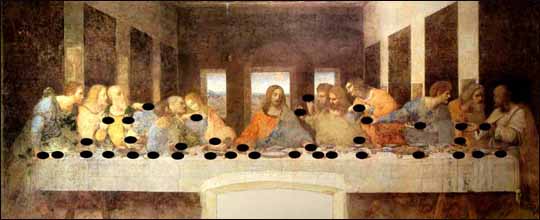
A computer technician has claimed to have cracked a real Da Vinci code, by finding musical notes encoded in the masterpiece The Last Supper. Leonardo Da Vinci left clues to a 40-second musical composition in his painting, Giovanni Maria Pala said.
Each loaf of bread in the picture represents a note, he said, which combine to sound "like a requiem". Alessandro Vezzosi, director of Tuscany's Da Vinci museum, said the theory was "plausible". The 15th century painting depicts Jesus' last meal with the 12 Apostles before his arrest and crucifixion. By drawing the five lines of a musical staff across the painting, the loaves of bread on the table and the hands of Jesus and the Apostles could each represent a musical note.
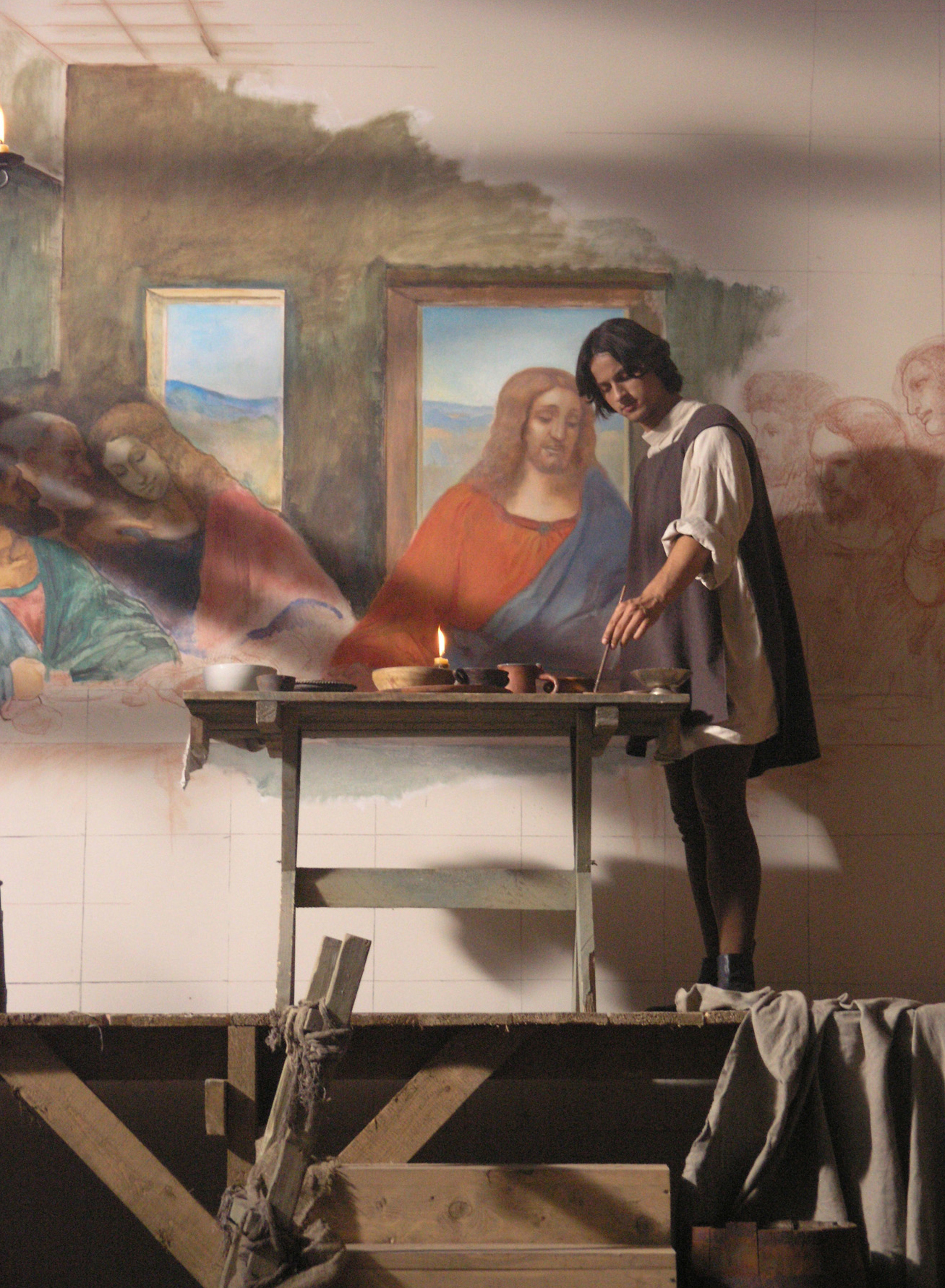
Leonardo was apprenticed to the artist Verrocchio in Florence when he was about 15.
In 1476 Leonardo worked with Verrocchio to paint for the friars of Vallombrosa The Baptism of Christ.
He painted the angel at the front and the landscape, and the difference between the two artists' work can be seen, with Leonardo's finer blending and brushwork. Giorgio Vasari told the story that when Verrochio saw Leonardo's work he was so amazed that he resolved never to touch a brush again.
Leonardo da Vinci painted several versions of the Madonna and Child, with notable examples including the Benois Madonna, the Madonna of the Carnation, and the Madonna Litta. He also created drawings and cartoons on the same theme, such as the Burlington House Cartoon. These works often feature the Virgin Mary with the infant Jesus, sometimes accompanied by other figures like Saint John the Baptist or Saint Anne.
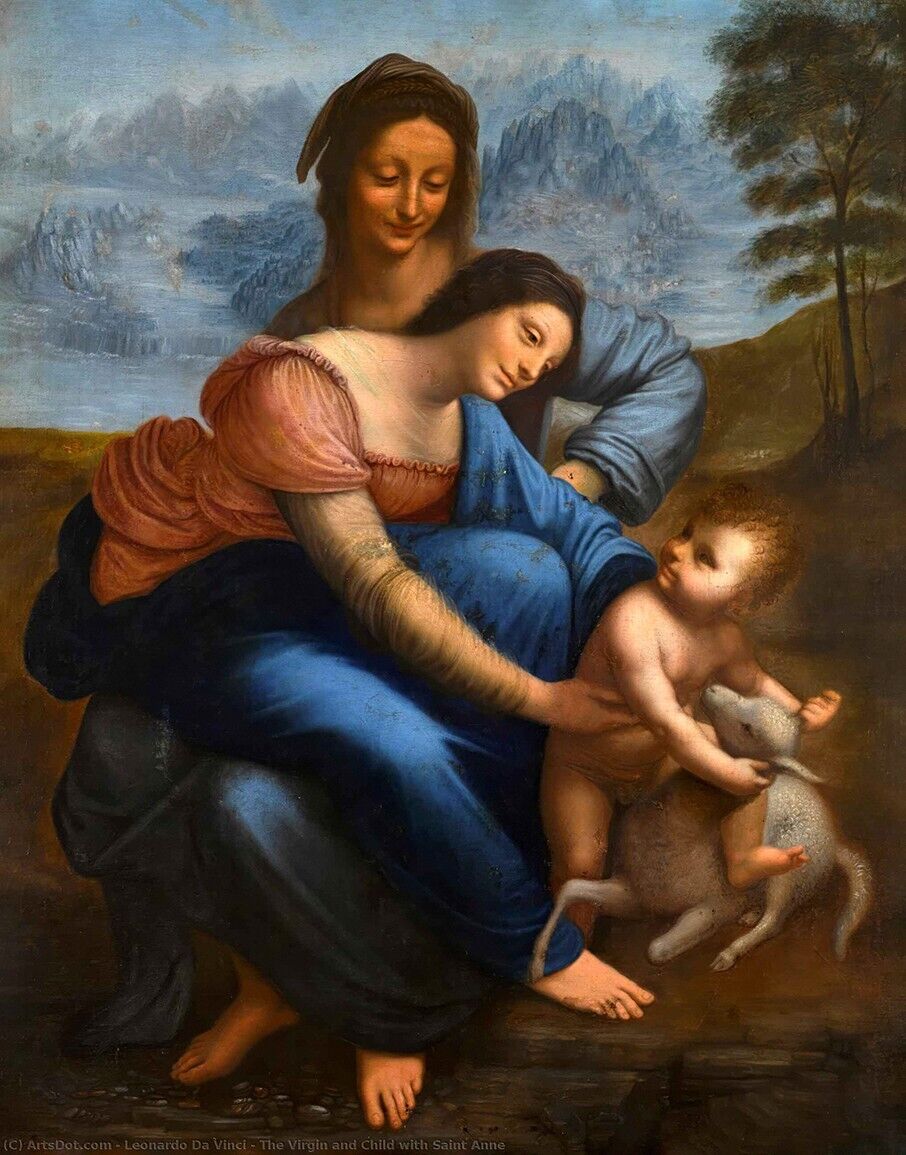
Leonardo's first painting completed wholly by himself was the Madonna and Child painting completed in 1478, he also painted at the same time a picture of a little boy eating sherbet.
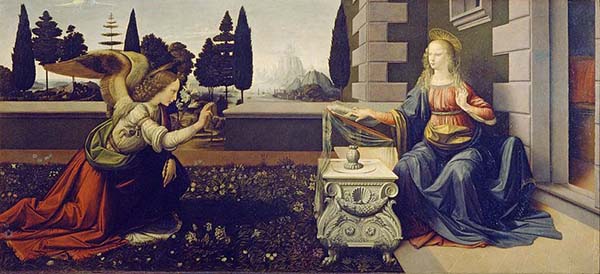
Da Vinci's Annunciation - Archangel Gabriel tells Mother Mary she will conceive Jesus Christ. In 1480-81 he created a small Annunciation painting which is now in the Louvre.
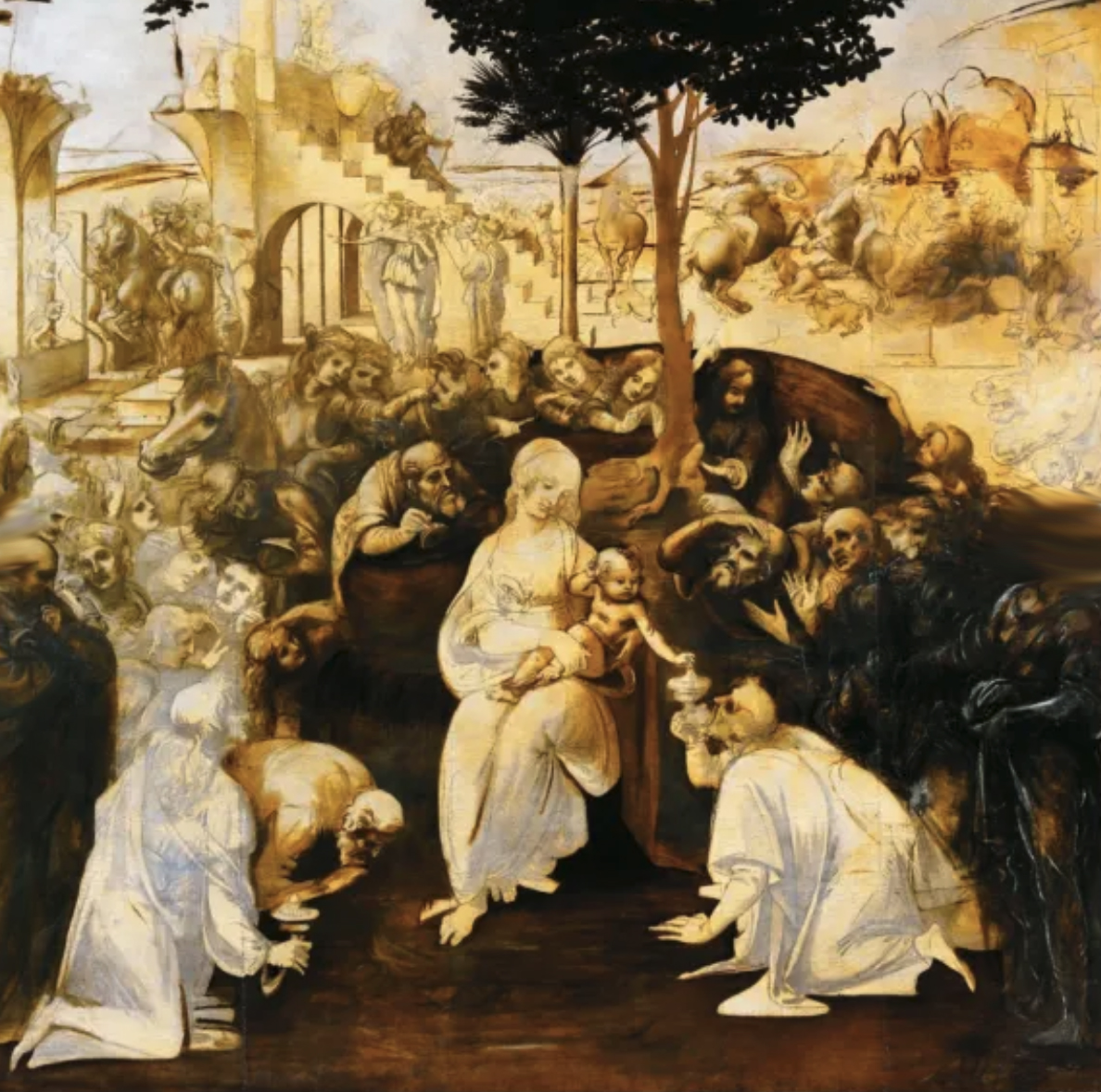
Between 1481 and 1482 he started a painting called The Adoration of the Kings (also known as The Adoration of the Magi). He made extensive, ambitious plans and many drawings for the painting, but it was not finished, as Leonardo's services had been accepted by the Duke of Milan, so he left before it was finished.
Milan (1482-1499) - Leonardo spent 17 years in Milan under the services of Duke Ludovico (between 1482 and 1499). He did many paintings, sculptures, and drawings during this time. He also designed court festivals, and did many of his sketches related to engineering.
He was given basically a free reign to work on any project he chose, though he left many projects unfinished, completing only about six paintings during this time.
This included The Last Supper (Ultima Cena or Cenacolo, in Milan) 1498 and Virgin of the Rocks (1494) . He worked on many of his notebooks between 1490 and 1495.
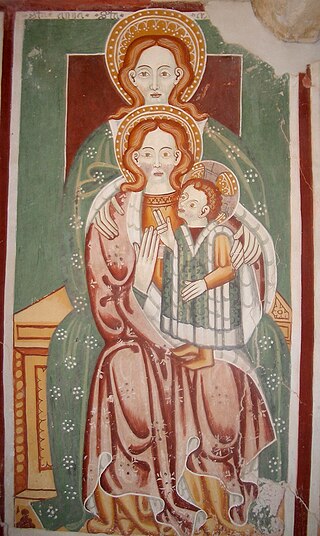
In 1499 he painted Madonna and Child with St. Anne.
He often planned grandiose paintings with many drawings and sketches, only to leave the projects unfinished. One of his projects involved making plans and models for a monumental seven metre (24 ft) high horse statue in bronze called "Gran Cavallo".
Because of war with France, the project was never finished. (In 1999 a pair of full-scale statues based on his plans were cast, one erected in Grand Rapids, Michigan, the other in Milan.) The Hunt Museum in Limerick, Ireland has a small bronze horse, thought to be the work of an apprentice from Leonardo's original design.
The French invaded Milan in 1499, and Ludovico Sforza lost control. Leonardo was forced to search for a new patron.
Nomadic Period - Italy and France (1499-1519)
Between 1499 and 1516 Leonardo worked for a number of people, travelling around Italy doing several commissions, before moving to France in 1516. This has been described as a 'Nomadic Period'.
In 1500 he went to Mantua where he sketched a portrait of the Marchesa Isabella d'Este.
Leonardo left for Venice in 1501. Soon after he returned to Florence where he was commissioned for a large public mural, "The Battle of Anghiari" - his rival Michelangelo was also commission to paint on the opposite wall.
After producing a fantastic variety of studies in preparation for the work, he left the city, with the mural unfinished due to technical difficulties. The painting was destroyed in a war in the middle of the sixteenth century.
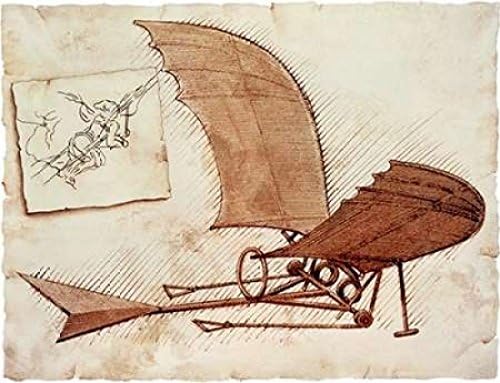
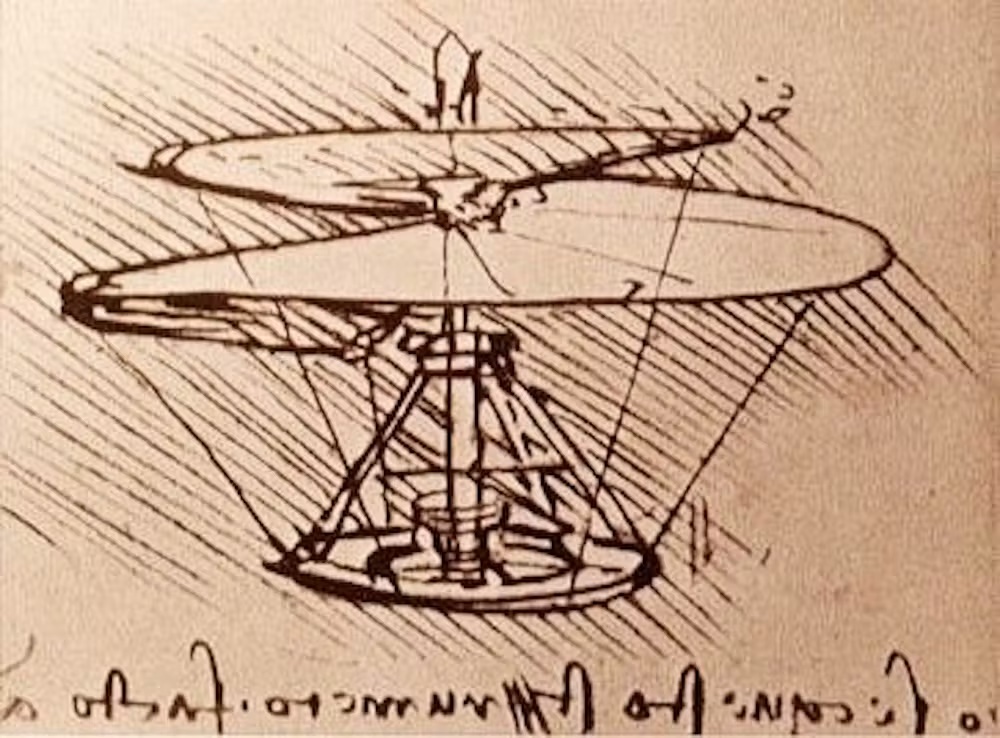
Fascinated by the phenomenon of flight, Leonardo produced detailed studies of the flight of birds, and plans for several flying machines, including a helicopter powered by four men (which would not have worked since the body of the craft would have rotated) and a light hang-glider which could have flown.
On January 3, 1496 he unsuccessfully tested a flying machine he had constructed. PBS aired a special about the building and testing of a glider based on Leonardo's design.
The glider was a resounding success. An armored tank designed by Leonardo at the Chateau d'Amboise.
In 1502 Leonardo da Vinci produced a drawing of a single span 720-foot (240 m) bridge as part of a civil engineering project for Sultan Beyazid II of Constantinople. The bridge was intended to span an inlet at the mouth of the Bosphorus known as the Golden Horn. It was never built, but Leonardo's vision was resurrected in 2001 when a smaller bridge based on his design was constructed in Norway.
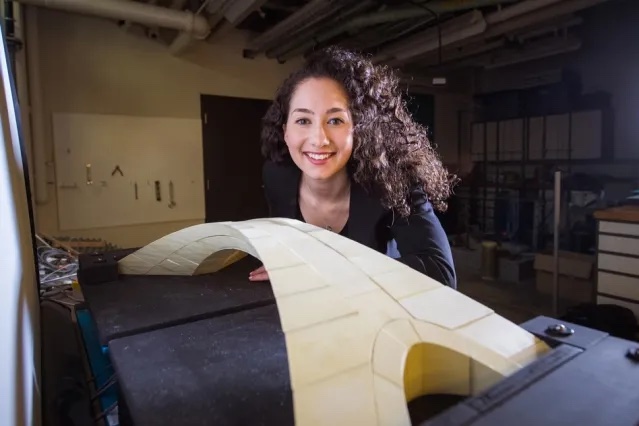
Scientists Prove Leonardo da Vinci's 500-Year-Old Bridge Design Actually Works Smithsonian - October 17, 2019
Leonardo da Vinci wasn't known for getting things done. He was often years or even decades late when delivering paintings, and many of the fantastical schemes he concocted (think giant horse statues and flying machines) barely progressed beyond the page. Still, new research conducted by engineers at MIT suggests one of the Renaissance giant's unbuilt designs - a bridge poised to be the world's longest - would have worked if the artist had actually followed through on his plans. Leonardo drafted his proposal in response to Sultan Bayezid II's 1502 appeal for bridge designs. Bayezid, ruler of the Ottoman Empire, wanted to connect the cities of Constantinople and Galata, which were separated by a river estuary called the Golden Horn.
Mechanical robot in the shape of a lion
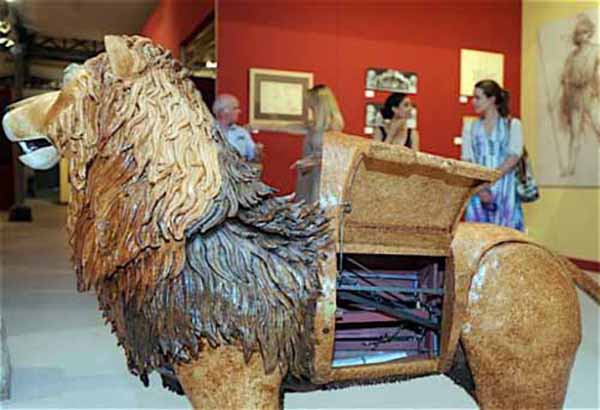
Car powered by a spring mechanism
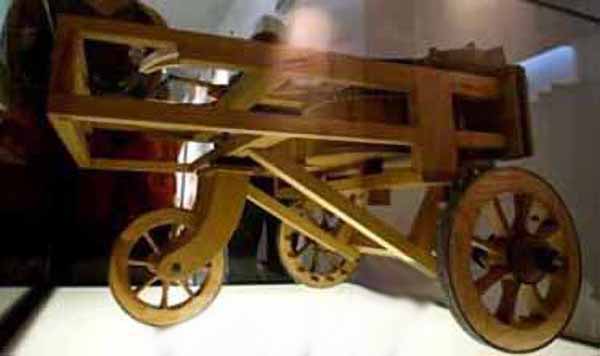
Mechanical Clock
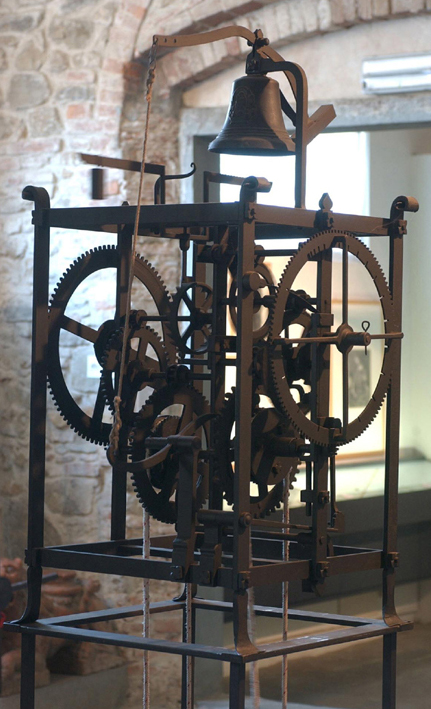
Other inventions include a submarine, a cog-wheeled device that has been interpreted as the first mechanical calculator, and more.
In his years at the Vatican, Leonardo planned an industrial use of solar power, by employing concave mirrors to heat water.
While most of Leonardo's inventions were not built during his lifetime, models of many of them have been constructed with the support of IBM and are on display at the Leonardo da Vinci Museum at the Chateau du Clos Luce in Amboise.
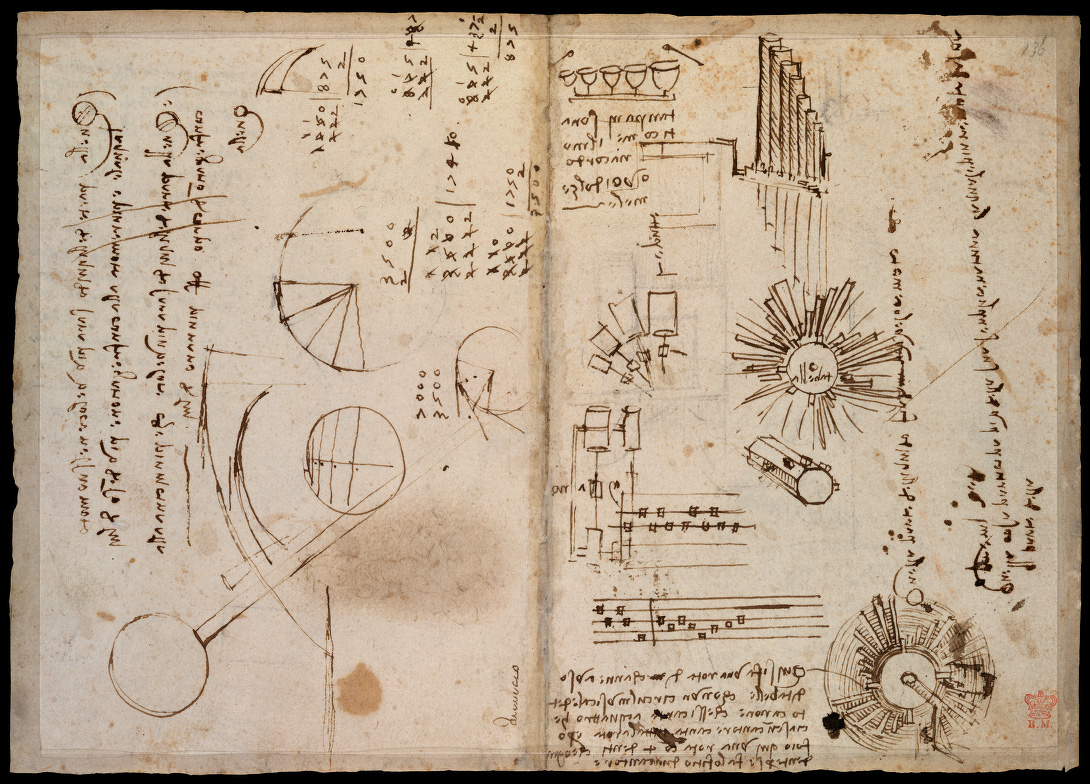
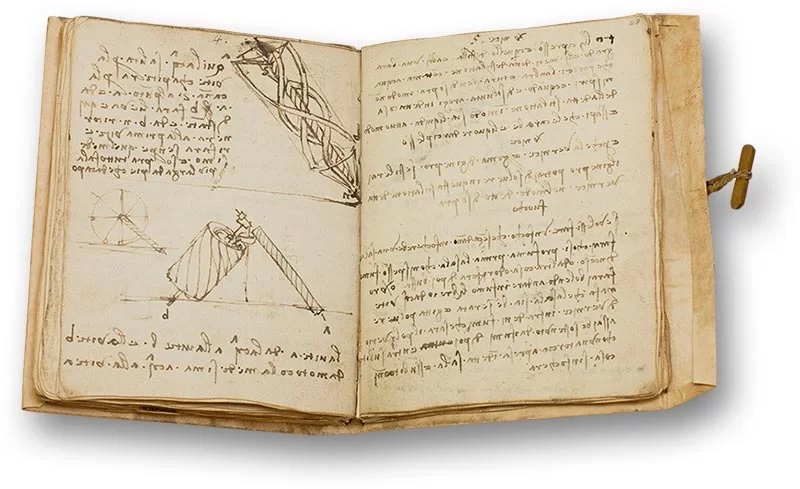
Leonardo's impressive and innovative artistic work in science and engineering were recorded in notebooks comprising some 13,000 pages of notes and drawings, which infuse art and science even today. These notes were made and maintained during Leonardo's travels through Europe.
The notebooks were on four main themes; architecture, elements of mechanics, painting, and human anatomy.
The manuscripts taken from the Biblioteca Ambrosiana in Milan to Paris by Napoleon in 1795 consist of twelve codices, labeled A to M. They offer an exceptional insight into LeonardoÕs life and works, covering a wide array of topics from geometry, physics, and mechanics to audacious technological concepts. These manuscripts intertwine autobiographical elements with observations on literary and artistic themes regarding the essence of the soul.
These 'notebooks' - originally loose papers of different types and sizes - were distributed by friends after his death - finding their way into major collections such as the Louvre, the Biblioteca Nacional de Espana, the Biblioteca Ambrosiana in Milan, and the British Library.
Enriched with masterful drawings, the smaller-sized notebooks serve as pocket-sized records where Leonardo captures fleeting thoughts, surprising ideas, and personal notes with acute perspicacity and quick sketches.
The larger notebooks feature more elaborate writings and drawings, including outlines for treatises on hydraulic sciences, flying machines, architecture, optics, and vision problems. These topics, particularly those related to the "science of the painter," find a more developed form in his "Treatise on Painting".
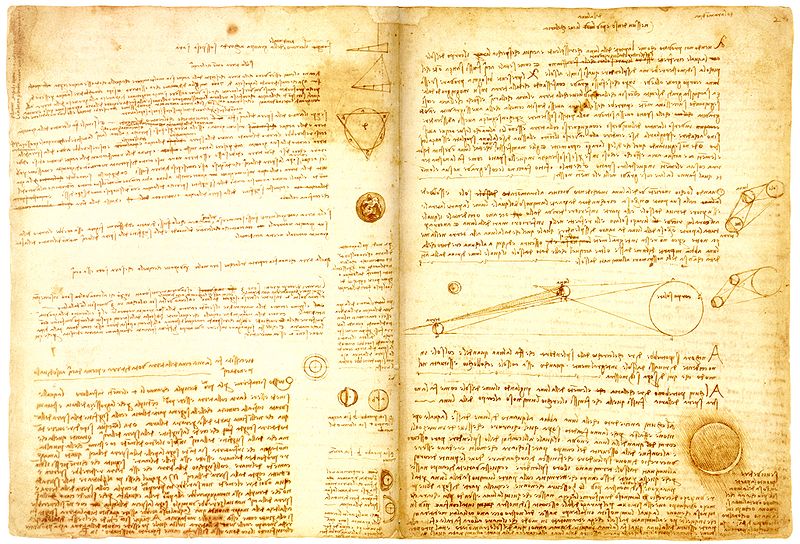
The Codex Leicester is the only major scientific work of Leonardo's in private hands. It is owned by Bill Gates, and is displayed once a year in different cities around the world. When the manuscript was last sold to Bill Gates at Christie's auction house on November 11, 1994 in New York for US $30,802,500 (equivalent to $65 million today), it was the most expensive manuscript ever sold.
Why Leonardo did not publish or otherwise distribute the contents of his notebooks remains a mystery.
He may have kept notebooks as if private journals to keep his work out of the hands of those who might irresponsibly use them as his notebooks contain several designs for military machines, machine guns, an armored tank powered by humans or horses, a cluster bombs, and more.
They remained obscure until the 19th century, and were not directly of value to the development of science and technology.
In January 2005, researchers discovered the hidden laboratory used by Leonardo for studies of flight and other pioneering scientific work in previously sealed rooms at a monastery next to the Basilica of the Santissima Annunziata, in the heart of Florence.
Throughout his life, he planned a grand encyclopedia based on detailed drawings of everything, but it was never completed or found.
Although he had no formal academic training, many historians and scholars regard Leonardo as the prime exemplar of the "Universal Genius" or "Renaissance Man", an individual of "unquenchable curiosity" and "feverishly inventive imagination."
He is widely considered one of the most diversely talented individuals ever to have lived. The scope and depth of his interests were without precedent in recorded history, and "his mind and personality seem to us superhuman, while the man himself mysterious and remote." Scholars interpret his view of the world as being based in logic, though the empirical methods he used were unorthodox for his time.
Leonardo's fame within his own lifetime was such that the King of France carried him away like a trophy, and was claimed to have supported him in his old age and held him in his arms as he died. Interest in Leonardo and his work has never diminished.
The Mona Lisa, considered Leonardo's magnum opus, is often regarded as the most famous portrait ever made. The Last Supper is the most reproduced religious painting of all time, and Leonardo's Vitruvian Man drawing is also considered a cultural icon.
While Leonardo was buried in the collegiate church of Saint Florentin at the Chateau d'Amboise in August 12,1519, the current location of his remains is unclear. Much of Chateau d'Amboise was damaged during the French Revolution, leading to the church's demolition in 1802.
Some of the graves were destroyed in the process, scattering the bones interred there and thereby leaving the whereabouts of Leonardo's remains subject to dispute; a gardener may have even buried some in the corner of the courtyard.
More than a decade of analysis of Leonardo's genetic genealogy, conducted by Alessandro Vezzosi and Agnese Sabato, came to a conclusion in mid-2021. It was determined that the artist has 14 living male relatives. The work could also help determine the authenticity of remains thought to belong to Leonardo.
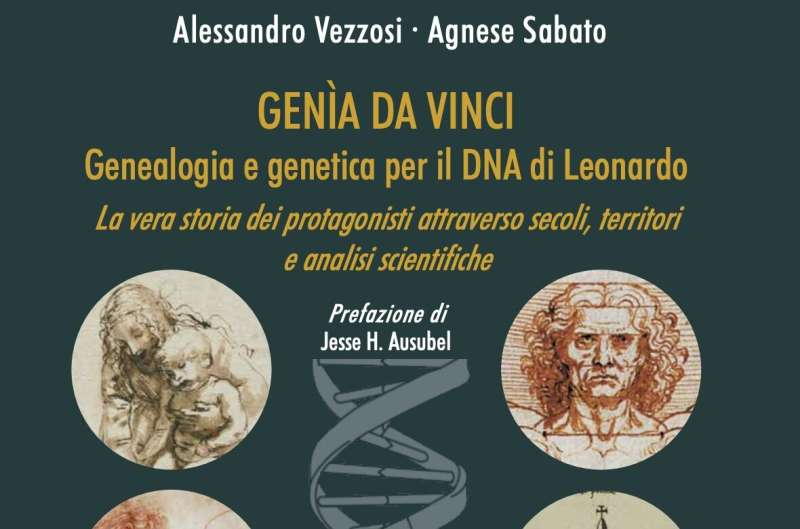
Leonardo da Vinci's DNA: Researchers confirm Y chromosome shared by six living family descendants PhysOrg - May 22, 2025
For more than five centuries, Leonardo Da Vinci has been celebrated as a visionary artist, scientist, and inventor, known for his extraordinary talent and groundbreaking experiments. Today, an international collaboration known as the Leonardo DNA Project is closer than ever to uncovering the biological secrets of the greatest genius of the Renaissance.
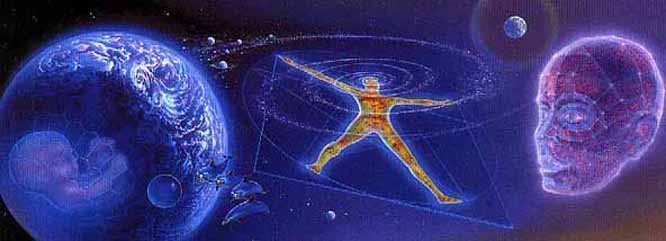
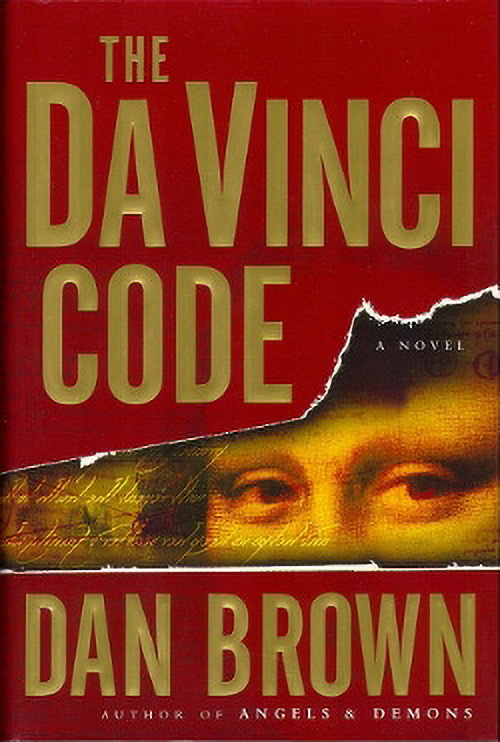
The The Da Vinci Code is a 2003 mystery thriller novel by Dan Brown. It is the best-selling American novel of all time. It's all about Jesus, Mary Magdalene, and their bloodline. In the book and film their daughter was named Sarah.


The Da Vinci Bloodline: Living Descendants Provide Clues to the Genius's Genetic Secrets SciTech Daily - September 12, 2025
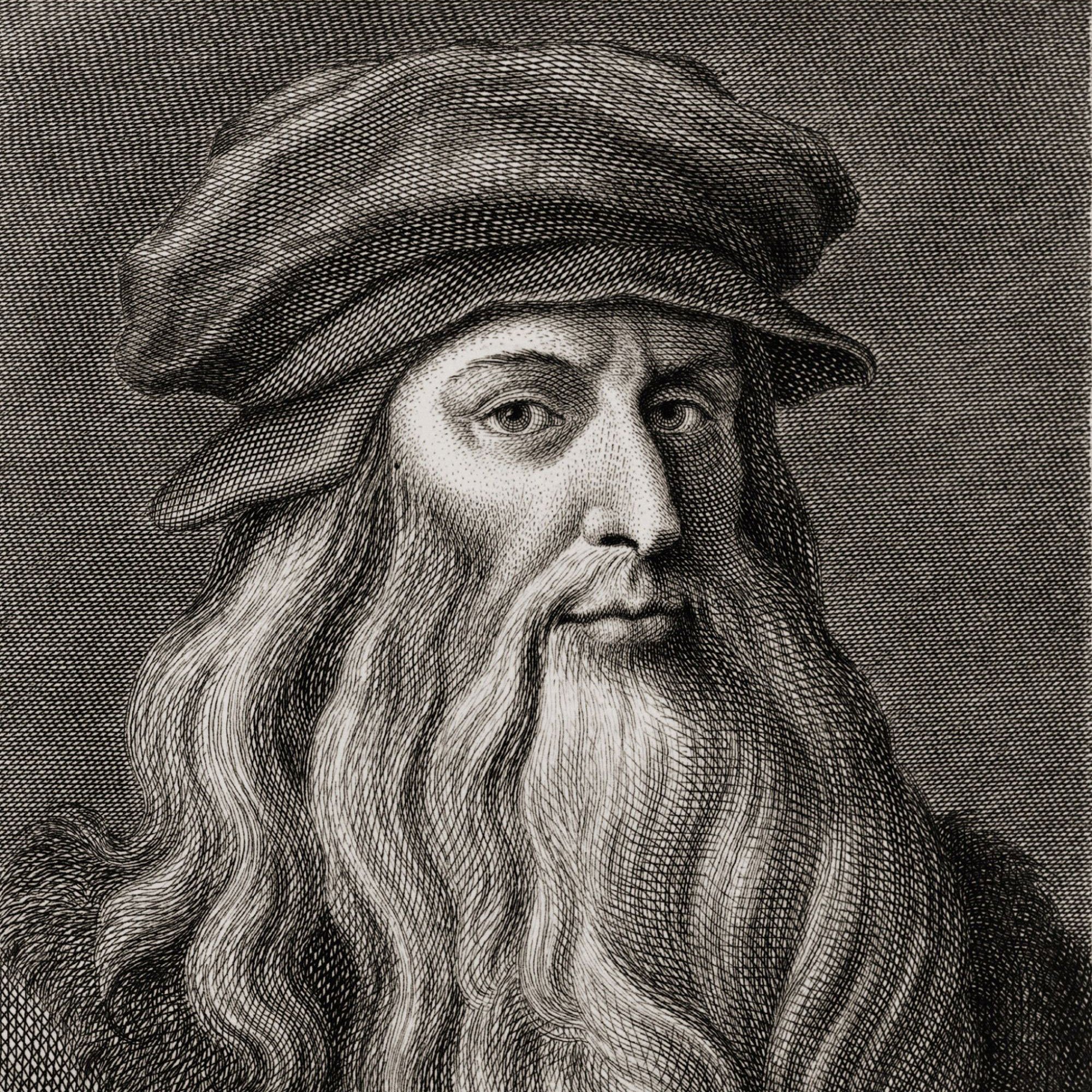
For centuries, Leonardo da VinciÕs genius has fascinated historians and scientists alike, but now researchers are closer than ever to uncovering his true biological legacy. A decades-long genealogical investigation has traced LeonardoÕs family line across 21 generations, opening the door to cutting-edge DNA analysis that may reconstruct his genetic profile.
Mysterious tunnels sketched by Leonardo da Vinci in 1495 may finally have been discovered - hidden under Sforza Castle in Milan Live Science - February 11, 2025
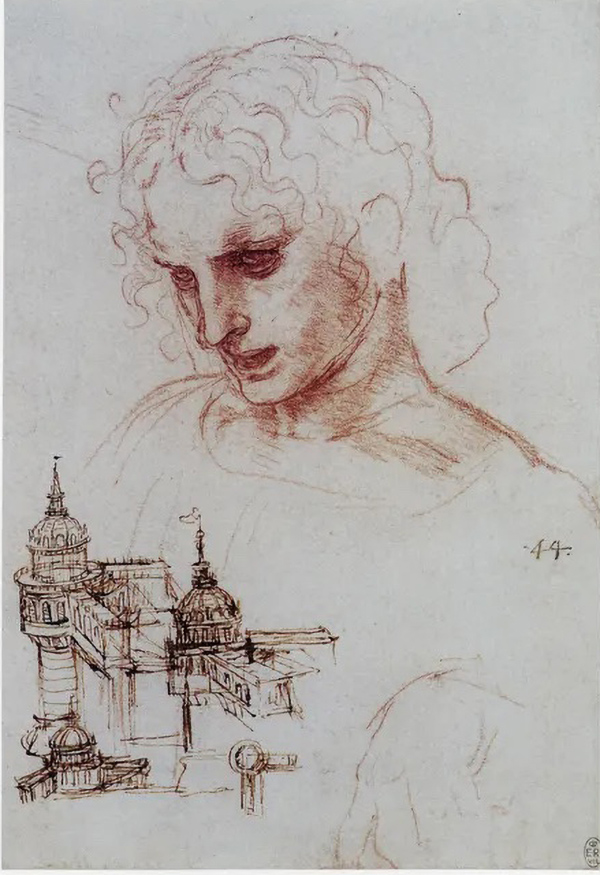
New algorithm helps uncover forgotten figures beneath Da Vinci painting Virgin of the Rocks PhysOrg - February 4, 2020
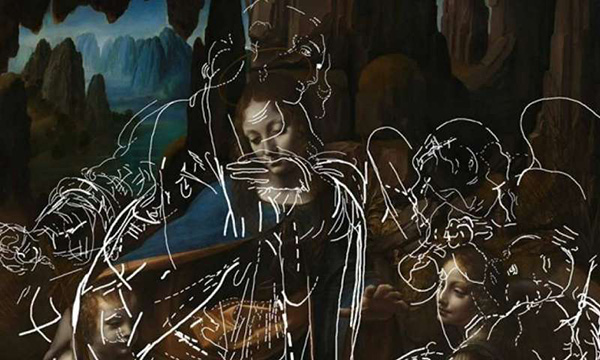
In doing so they revealed, more clearly than ever before, the hidden figures that Leonardo first drew before changing his design to the one that he eventually painted. These included abandoned images of an angel and the Infant Christ.
Leonardo's 'claw hand' stopped him painting BBC - May 4, 2019
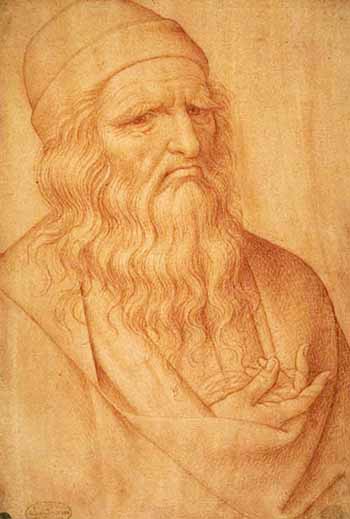
Leonardo da Vinci could have experienced nerve damage in a fall, impeding his ability to paint in later life, Italian doctors suggest. They diagnosed ulnar palsy, or "claw hand", by analyzing the depiction of his right hand in two artworks. It had been suggested that Leonardo's hand impairment was caused by a stroke. But in the Journal of the Royal Society of Medicine, the doctors suggest it was nerve damage that meant he could no longer hold a palette and brush. Leonardo da Vinci, who lived from 1452-1519, was an artist and inventor whose talents included architecture, anatomy, engineering and sculpture, as well as painting. But art historians have debated which hand he used to draw and paint with.
The Da Vinci Glow PhysOrg - October 6, 2005

Five hundred years ago, Leonardo Da Vinci solved an ancient astronomical riddle: the mystery of Earthshine. When you think of Leonardo Da Vinci, you probably think of the Mona Lisa or 16th-century submarines or, maybe, a certain suspenseful novel. That's old school. From now on, think of the Moon.